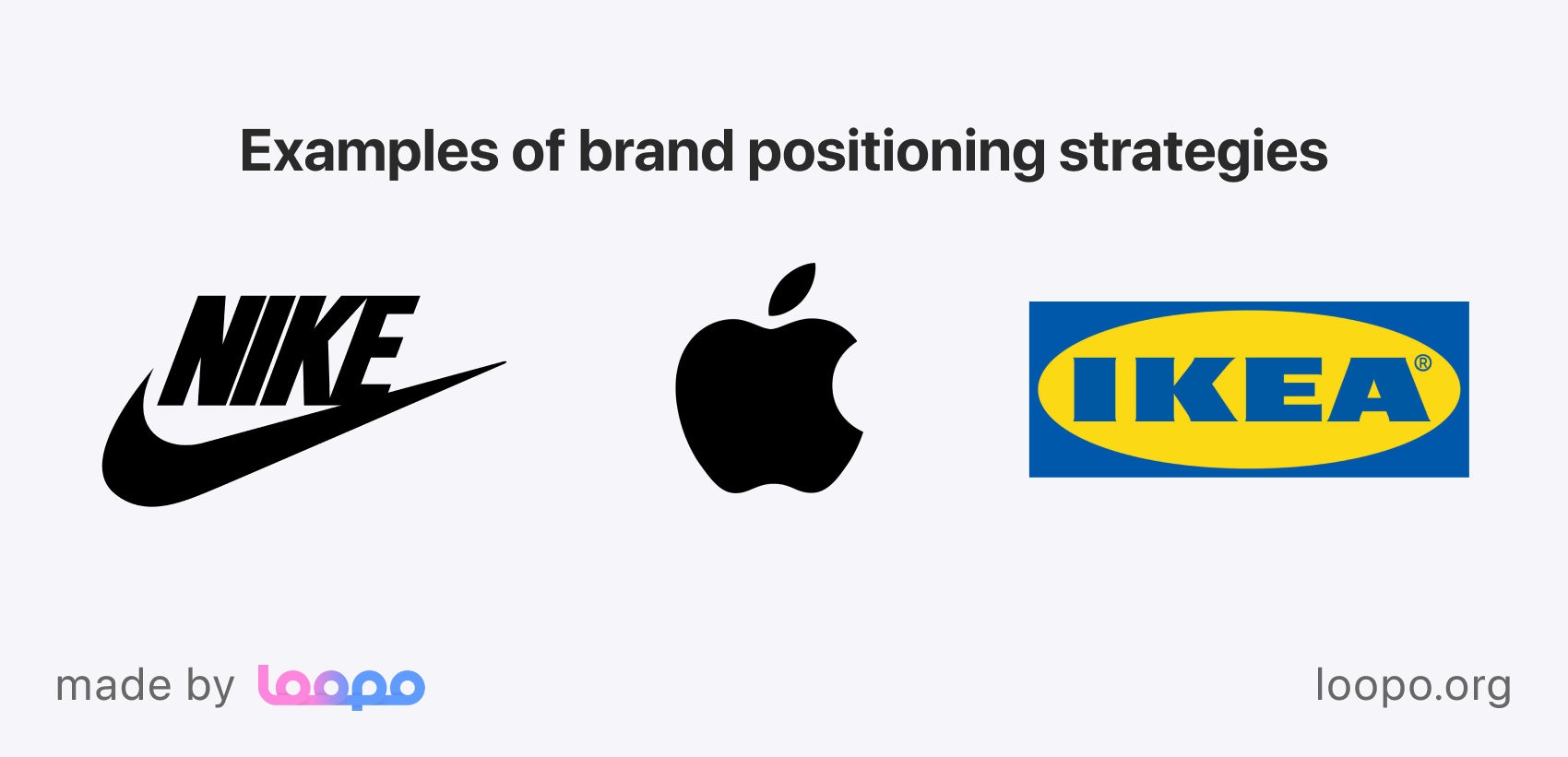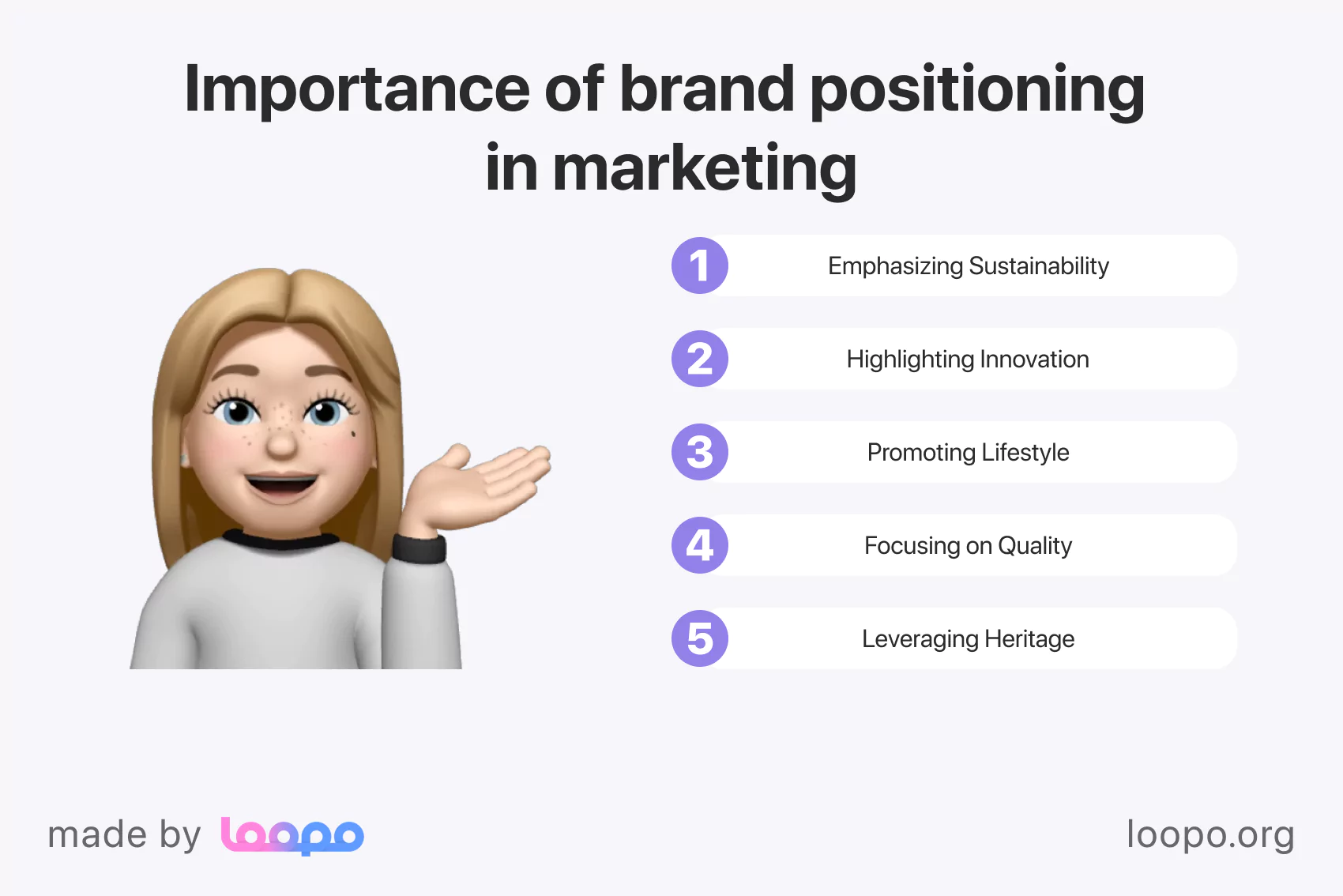What is the Difference Between Branding and Positioning?

In today’s fiercely competitive market, businesses must strategically navigate the realms of branding and positioning to stand out and resonate with their target audiences. While often used interchangeably, branding and positioning serve distinct yet complementary roles in a company’s marketing strategy.
Understanding the difference between these two concepts is crucial for building a strong, recognizable brand that effectively meets consumer needs and expectations.
Understanding Branding
Brand Definition
At its core, a brand represents the identity of a company, encompassing its values, personality, and the promises it makes to customers. It's the sum of experiences, perceptions, and emotions associated with a business and its products or services. Branding is not just about a logo or a catchy tagline; it’s about creating a meaningful and lasting impression in the minds of consumers.
Elements of Branding
Branding involves several key elements that collectively shape a company’s identity:
Logo and Visual Identity: The visual symbols and design elements that make a brand recognizable. This includes colors, typography, and imagery that consistently represent the brand.
Brand Voice and Messaging: The tone and language used to communicate with the audience. Whether formal, casual, or playful, the brand voice helps convey the brand’s personality.
Values and Mission: The principles and goals that guide the company’s actions and decisions. These core values reflect what the brand stands for and its commitment to customers and the community.
Customer Experience: The interactions and experiences customers have with the brand across various touchpoints, including customer service, product quality, and user interface.
Brand Story: The narrative that conveys the brand’s history, purpose, and journey. A compelling brand story can create an emotional connection with the audience.
Importance of Branding
Effective branding builds trust and loyalty among customers. It differentiates a company from its competitors and creates a memorable impression that can influence purchasing decisions. A strong brand also supports marketing efforts by providing a clear and consistent message that resonates with the target audience.
Moreover, branding can enhance the perceived value of a product or service, allowing businesses to command premium prices and foster long-term customer relationships.

Building a Strong Brand
Building a strong brand requires a strategic approach that aligns all aspects of the business with the brand’s core values and mission. Key steps include:
Define Your Brand Identity
Clearly articulate what your brand stands for, including its mission, vision, and values.
Create a Consistent Visual Identity
Develop a cohesive visual style that reflects your brand’s personality and appeals to your target audience.
Develop a Unique Brand Voice
Establish a consistent tone and style for all communications to ensure your brand is easily recognizable.
Deliver Exceptional Customer Experience
Ensure every interaction with your brand exceeds customer expectations, fostering loyalty and positive word-of-mouth.
Communicate Your Brand Story
Share your brand’s narrative across various channels to create an emotional connection with your audience.
Understanding Positioning
Brand Positioning Definition
Brand positioning refers to the strategic process of establishing a brand's unique place in the market and in the minds of consumers. It defines how a brand differentiates itself from competitors and communicates its unique value proposition.
Effective brand positioning ensures that the brand occupies a distinct and desirable position relative to other brands in the minds of the target audience.
What is Brand Positioning?
Brand positioning is about identifying and articulating the distinctive benefits and values that set a brand apart. This involves understanding the target audience, analyzing competitors, and determining the unique selling points that make the brand preferable.
Brand positioning answers the question: "Why should consumers choose your brand over others?"
Importance of Brand Positioning
Brand positioning is critical because it directly influences consumer perception and buying behavior. A well-defined positioning strategy ensures that the brand remains relevant and appealing to its target market, fostering brand loyalty and long-term success.
It helps businesses carve out a unique space in a crowded marketplace, making it easier for consumers to understand and remember the brand.

Crafting a Brand Positioning Statement
A brand positioning statement is a concise description of your target market, the unique value your brand offers, and how it differs from competitors. It serves as a guide for all marketing and branding efforts, ensuring consistency and clarity in messaging.
Components of a Positioning Statement:
Target Audience: Define who your ideal customers are.
Market Definition: Specify the category or industry your brand operates in.
Unique Selling Proposition (USP): Highlight what makes your brand unique.
Brand Promise: State the key benefit or value your brand delivers.
Example Positioning Statement: "For environmentally conscious consumers (target audience) seeking high-quality, sustainable apparel (market definition), EcoWear offers stylish and eco-friendly clothing (USP) that helps reduce environmental impact (brand promise)."
Branding vs. Positioning: Key Differences
Focus and Objectives
Branding focuses on creating a holistic identity and emotional connection with the audience. Its objective is to build recognition, trust, and loyalty. Positioning concentrates on establishing a unique market stance relative to competitors. Its goal is to highlight specific attributes that make the brand the preferred choice.
Strategies and Tactics
Branding strategies include developing a consistent visual identity, crafting a compelling brand story, and maintaining uniform messaging across all channels. Positioning strategies involve market research, identifying unique selling propositions, and tailoring messages to emphasize the brand’s distinct advantages.
Outcomes and Impact
Branding leads to a strong, recognizable identity that fosters long-term customer relationships. Positioning results in a clear, differentiated market presence that attracts the target audience and drives competitive advantage.
Interaction Between Branding and Positioning
While branding and positioning are distinct, they work together to create a cohesive and effective marketing strategy. Branding establishes the overall identity and emotional connection, while positioning ensures that the brand occupies a unique and desirable place in the market. Together, they enhance brand equity, increase market share, and drive business growth.
Developing a Brand Positioning Strategy
Brand Positioning Process
Creating an effective brand positioning strategy involves several steps:
Market Research: Understanding the market landscape, including customer needs, preferences, and competitor offerings.
Target Audience Identification: Defining the specific group of consumers the brand aims to reach.
Unique Selling Proposition (USP): Determining what makes the brand unique and valuable to the target audience.
Positioning Statement: Crafting a clear and concise statement that encapsulates the brand’s unique position.
Implementation and Communication: Ensuring that all marketing efforts consistently reflect the positioning strategy.
Conducting Market Research
Market research is the foundation of a successful brand positioning strategy. It involves gathering and analyzing data about the market, competitors, and consumers. Key aspects include:
Consumer Insights: Understanding customer needs, preferences, and behaviors.
Competitive Analysis: Identifying key competitors and analyzing their strengths and weaknesses.
Market Trends: Keeping abreast of industry developments and emerging trends.
Defining Your Target Audience
Clearly identifying your target audience is essential for effective brand positioning. This involves segmenting the market based on demographics, psychographics, behavior, and other relevant criteria. A well-defined target audience allows you to tailor your messaging and offerings to meet their specific needs and preferences.
Identifying Your Unique Selling Proposition (USP)
Your USP is what sets your brand apart from competitors. It highlights the unique benefits and values that your brand offers to customers. A strong USP is clear, compelling, and relevant to your target audience.
Crafting a Positioning Statement
A positioning statement serves as a guiding framework for your branding and marketing efforts. It succinctly communicates your brand’s unique position in the market and helps ensure consistency in your messaging.
Example Positioning Statement: "For busy professionals (target audience) who value efficiency and reliability (needs), our time-saving productivity app (brand) offers intuitive features and seamless integration (USP), helping users maximize their productivity without added stress (brand promise)."
Implementing and Communicating Your Positioning
Once you have developed your brand positioning strategy, it’s crucial to implement and communicate it effectively across all marketing channels. This ensures that your brand’s unique position is consistently conveyed to the target audience.
Key Implementation Steps:
Integrate Positioning into Marketing Materials: Ensure that your positioning is reflected in your website, advertising, social media, and other marketing materials.
Train Your Team: Educate employees about the brand positioning to ensure consistency in customer interactions.
Monitor and Adjust: Continuously assess the effectiveness of your positioning strategy and make adjustments as needed based on market feedback and changing conditions.
Brand Positioning Strategy Examples
Apple
Positioned as a premium brand offering innovative and high-quality technology products. Apple's focus on design, user experience, and cutting-edge technology differentiates it from competitors.
Nike
Positioned around athletic performance and inspiring athletes. Nike’s messaging emphasizes motivation, excellence, and the pursuit of greatness.
IKEA
Positioned as a provider of affordable, stylish home furnishings with a DIY approach. IKEA combines functionality, affordability, and modern design to appeal to cost-conscious consumers.

Integrating Branding and Positioning in Marketing
Brand Strategy and Positioning
A cohesive brand strategy and positioning plan ensures that branding efforts support the overall positioning objectives. This alignment helps create a unified brand message that resonates with the target audience. Key elements include:
Unified Messaging: Ensuring that all communications reflect the brand’s positioning.
Integrated Marketing Campaigns: Coordinating marketing efforts across different channels to reinforce the brand’s position.
Consistent Visual and Verbal Identity: Maintaining uniformity in design and messaging to strengthen brand recognition.
Brand Positioning in Marketing
Brand positioning in marketing involves using various marketing channels and tactics to communicate the brand’s unique position. This includes advertising, content marketing, social media, and public relations efforts tailored to highlight the brand’s strengths.
Effective marketing strategies ensure that the brand’s position is clearly conveyed to the target audience, fostering engagement and loyalty.
Positioning Brand Through Content Marketing
Content marketing is a powerful tool for positioning your brand. By creating valuable and relevant content that aligns with your brand’s positioning, you can establish authority, build trust, and engage with your audience on a deeper level. Strategies include:
Educational Content: Providing information that helps your audience solve problems or learn something new.
Storytelling: Sharing stories that reflect your brand’s values and mission.
Thought Leadership: Positioning your brand as an expert in your industry through insightful articles, whitepapers, and webinars.
Utilizing Social Media for Brand Positioning
Social media platforms offer unique opportunities to position your brand by engaging directly with your audience. Through strategic content creation, community management, and influencer partnerships, brands can reinforce their positioning and build a loyal following.
Strategies for Social Media Brand Positioning:
Consistent Posting: Regularly sharing content that aligns with your brand’s positioning.
Engaging with Followers: Responding to comments, messages, and interactions to build relationships.
Influencer Collaborations: Partnering with influencers who embody your brand’s values and can amplify your positioning message.
Public Relations and Brand Positioning
Public relations efforts can significantly impact brand positioning by managing the brand’s reputation and increasing its visibility. Effective PR strategies include media outreach, press releases, and crisis management, all aimed at maintaining a positive brand image and reinforcing the brand’s position in the market.
Key PR Strategies for Brand Positioning:
Media Relations
Building relationships with journalists and media outlets to secure positive coverage.
Press Releases
Announcing significant company news, product launches, or milestones to shape public perception.
Crisis Management
Handling negative publicity or issues promptly and effectively to protect the brand’s reputation.
The Importance of Brand Positioning
Brand Positioning Meaning
The brand positioning meaning lies in its ability to define how a brand is perceived in the marketplace. It communicates the brand’s unique value proposition and establishes a clear identity that differentiates it from competitors. A strong brand position helps consumers understand why they should choose your brand over others.
Benefits of Effective Brand Positioning
Differentiation: Clearly distinguishes your brand from competitors.
Customer Loyalty: Builds trust and emotional connections, leading to repeat business.
Market Relevance: Ensures your brand remains pertinent to your target audience’s needs and preferences.
Competitive Advantage: Provides a strategic edge that can lead to increased market share and profitability.
Brand Positioning Ideas
Innovative brand positioning ideas can help your brand stand out in a crowded market. Some effective strategies include:
Emphasizing Sustainability
Positioning the brand as environmentally friendly and socially responsible.
Highlighting Innovation
Focusing on cutting-edge technology and continuous improvement.
Promoting Lifestyle
Associating the brand with a particular lifestyle or set of values that resonate with the target audience.
Focusing on Quality
Emphasizing superior quality and craftsmanship.
Leveraging Heritage
Highlighting the brand’s history and legacy to build trust and authenticity.
Brand Positioning Marketing
Effective brand positioning marketing leverages the brand’s unique position to create targeted campaigns that speak directly to the intended audience. This approach enhances engagement and drives brand loyalty by ensuring that all marketing messages align with the brand’s positioning strategy.

The Role of Brand Positioning in Customer Decision-Making
Brand positioning plays a crucial role in influencing customer decision-making. By clearly communicating the brand’s unique benefits and values, it helps consumers make informed choices that align with their needs and preferences.
Effective positioning reduces ambiguity, making it easier for customers to understand why they should choose your brand over competitors.
Advanced Strategies for Brand Positioning
Emotional Positioning
Emotional positioning focuses on creating an emotional connection with the audience. By appealing to emotions such as happiness, trust, or excitement, brands can foster deeper relationships with consumers. Emotional branding can lead to higher customer loyalty and advocacy, as consumers are more likely to support brands they feel emotionally connected to.
Strategies for Emotional Positioning:
Storytelling: Sharing stories that resonate emotionally with the audience.
Brand Personality: Developing a relatable and authentic brand personality.
Customer Engagement: Creating interactive and engaging experiences that evoke emotions.
Competitive Positioning
Competitive positioning involves analyzing competitors and finding ways to differentiate the brand. This could be through better quality, unique features, or superior customer service. Understanding your competitors’ strengths and weaknesses allows you to position your brand in a way that highlights your unique advantages.
Strategies for Competitive Positioning:
Benchmarking: Comparing your brand’s performance and offerings against competitors.
Identifying Gaps: Finding unmet needs or underserved segments in the market.
Highlighting Unique Features: Emphasizing aspects of your product or service that competitors do not offer.
Value-Based Positioning
Value-based positioning emphasizes the value the brand provides to customers, not just the price. It highlights the benefits and advantages that make the brand worth the investment. This approach focuses on delivering superior value through quality, functionality, and customer service.
Strategies for Value-Based Positioning:
Benefit Communication: Clearly communicating the tangible and intangible benefits of your product or service.
Quality Assurance: Ensuring consistent quality to meet or exceed customer expectations.
Enhanced Services: Offering additional services or support that add value for customers.
Cultural Positioning
Cultural positioning aligns the brand with specific cultural values or movements. This strategy resonates with consumers who share those values, creating a strong community around the brand. Cultural positioning can enhance brand loyalty and advocacy by fostering a sense of belonging among customers.
Strategies for Cultural Positioning:
Aligning with Social Causes: Supporting causes that reflect the brand’s values and resonate with the target audience.
Cultural Relevance: Ensuring that the brand’s messaging and imagery are culturally relevant and sensitive.
Community Building: Creating platforms for customers to engage and connect around shared values.
Technological Positioning
For brands in tech-driven industries, technological positioning highlights innovation, advanced features, and cutting-edge solutions, appealing to tech-savvy consumers. This strategy emphasizes the brand’s commitment to staying ahead of technological advancements and continuously improving its offerings.
Strategies for Technological Positioning:
Showcasing Innovation: Highlighting new technologies and innovative features.
Thought Leadership: Positioning the brand as an industry leader through insights and expertise.
User Experience: Focusing on intuitive and user-friendly designs that leverage technology to enhance functionality.
Measuring the Success of Brand Positioning
Key Performance Indicators (KPIs)
To assess the effectiveness of brand positioning, businesses can track various KPIs:
Brand Awareness: Measures how well consumers recognize the brand.
Market Share: Indicates the brand’s position relative to competitors.
Customer Loyalty: Assesses repeat purchases and brand advocacy.
Perceived Value: Evaluates how customers perceive the brand’s value.
Engagement Metrics: Includes likes, shares, comments, and other forms of interaction on digital platforms.
Sales Growth: Tracks the increase in sales as an indicator of successful positioning.
Customer Satisfaction: Measures how satisfied customers are with the brand’s offerings.
Feedback and Adaptation
Gathering feedback from customers through surveys, reviews, and direct interactions helps in understanding the effectiveness of the positioning strategy. Brands should be ready to adapt their strategies based on this feedback to stay relevant. Continuous improvement and responsiveness to customer needs are vital for maintaining a strong brand position.
Case Studies
Examining successful brand positioning through case studies can provide valuable insights. For example, Tesla’s positioning around innovation and sustainability has set it apart in the automotive industry, attracting a loyal customer base and driving significant market growth.
Similarly, Spotify positions itself as the leading music streaming service by offering personalized playlists and a vast library of songs, differentiating it from competitors.

Analytics Tools
Using analytics tools can help track and measure the effectiveness of brand positioning. Tools like Google Analytics, social media analytics, and customer relationship management (CRM) systems provide valuable data on customer behavior, engagement, and satisfaction.
Analyzing this data allows brands to make informed decisions and refine their positioning strategies.
Common Mistakes in Brand Positioning
Considering Lack of Clarity
A vague positioning statement can confuse consumers. It’s essential to have a clear and concise statement that communicates the brand’s unique value. Ambiguity in positioning can lead to inconsistent messaging and weaken the brand’s impact.
Ignoring the Target Audience
Failing to understand and address the needs and preferences of the target audience can lead to ineffective positioning. Brands must tailor their positioning strategies to resonate with their specific audience. This involves conducting thorough market research and continuously engaging with customers to stay attuned to their evolving needs.
Overlooking Competitors
Neglecting to analyze and differentiate from competitors can result in a weak market position. Understanding what competitors offer helps in identifying unique selling propositions and opportunities for differentiation. Brands must continuously monitor the competitive landscape to stay ahead.
Inconsistent Messaging
Inconsistent messaging across different channels can dilute the brand’s position. Maintaining uniformity in communication ensures that the brand’s position is clearly conveyed. Inconsistencies can create confusion and weaken the overall brand identity.
Focusing Solely on Features
Highlighting only the features of a product or service without emphasizing the benefits can make the positioning less compelling. It’s important to communicate how the brand improves the customer’s life and addresses their needs. Focusing on benefits rather than features creates a stronger emotional connection with the audience.
Neglecting Emotional Connection
Failing to create an emotional connection with the audience can limit the effectiveness of brand positioning. Emotional branding helps in building deeper relationships with consumers, fostering loyalty and advocacy. Brands must strive to connect with their audience on an emotional level to enhance engagement and loyalty.
Overcomplicating the Positioning
A complex positioning strategy can be difficult to communicate and understand. Simplicity and clarity are key to effective brand positioning. Brands should aim for straightforward and easily understandable positioning that clearly conveys their unique value.
Conclusion
Understanding the difference between branding and positioning is essential for crafting a successful marketing strategy. Branding builds the overall identity and emotional connection with consumers, while positioning strategically places the brand within the market to highlight its unique advantages.
By implementing effective brand positioning strategies and maintaining a strong brand identity, businesses can navigate competitive landscapes and achieve their marketing goals. Whether you're a startup looking to establish your brand or an established company aiming to refine your positioning, understanding and leveraging the distinctions between branding and positioning can significantly enhance your market presence and drive sustainable growth.
Explore valuable insights on our blog and reach out to us for tailored solutions designed to meet your needs.



